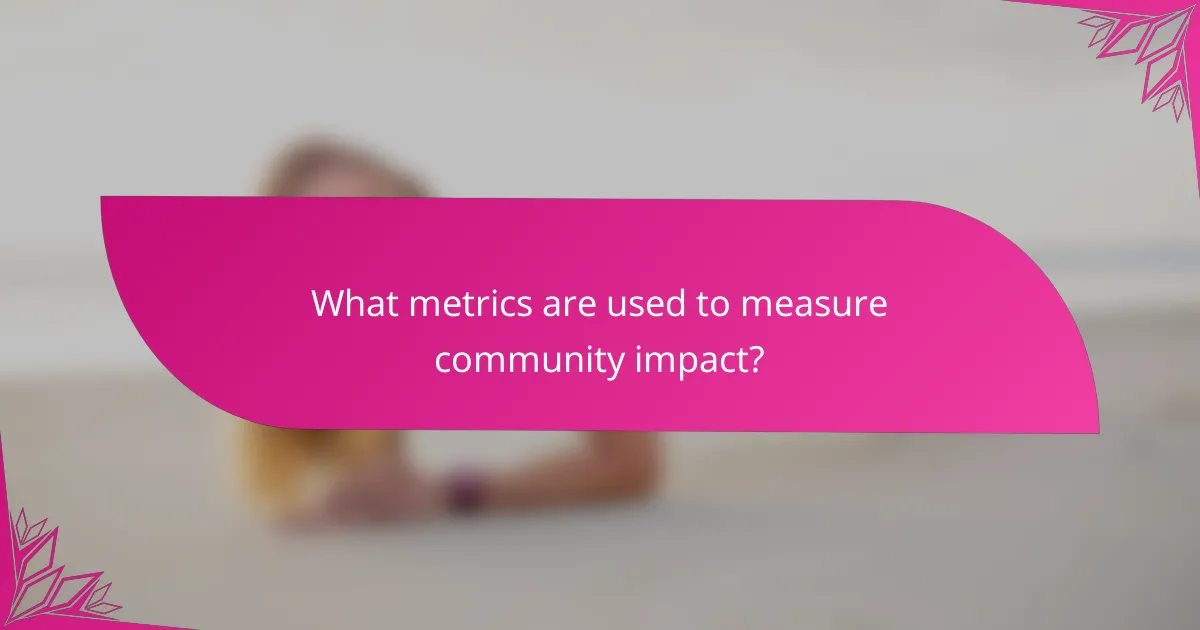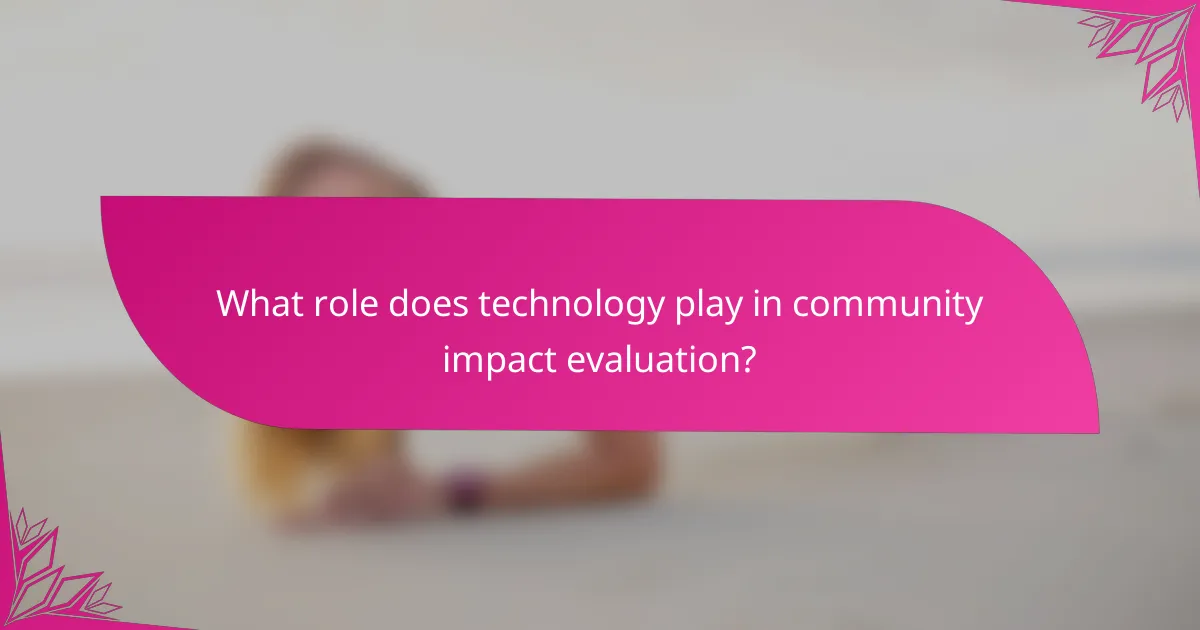Evaluating community impact is essential for understanding the effectiveness of initiatives and their influence on local populations. By employing both qualitative and quantitative methods, organizations can utilize metrics such as social return on investment and community engagement levels to gauge success. Key factors for achieving meaningful impact include setting clear objectives, fostering strong partnerships, and maintaining effective communication with stakeholders.

How to evaluate community impact effectively?
Evaluating community impact effectively involves a combination of qualitative and quantitative methods to assess how initiatives influence the community. This process requires careful consideration of metrics, stakeholder feedback, and real-world examples to understand the overall effectiveness of community programs.
Qualitative assessment methods
Qualitative assessment methods focus on gathering in-depth insights through interviews, focus groups, and open-ended surveys. These approaches allow for a nuanced understanding of community experiences and perceptions regarding specific initiatives.
To implement qualitative assessments, consider conducting regular community meetings or workshops where participants can share their thoughts and feelings. This can help identify strengths and weaknesses in programs and highlight areas for improvement.
Quantitative metrics
Quantitative metrics involve numerical data that can be statistically analyzed to measure community impact. Common metrics include participation rates, demographic changes, and economic indicators such as income levels or employment rates.
When selecting quantitative metrics, ensure they align with the goals of your community initiatives. For example, if a program aims to reduce unemployment, tracking job placement rates over time can provide clear evidence of impact.
Stakeholder feedback
Stakeholder feedback is crucial for understanding the effectiveness of community programs. Engaging with community members, local businesses, and organizations can provide valuable perspectives on how initiatives are perceived and their actual impact.
To gather feedback, consider using structured surveys or informal discussions. Regularly reviewing this feedback can help adjust programs to better meet community needs and enhance overall effectiveness.
Case studies analysis
Case studies analysis involves examining specific instances of community initiatives to draw lessons and insights. By analyzing successful and unsuccessful programs, organizations can identify best practices and common pitfalls.
When conducting case studies, focus on diverse examples from similar communities to understand different contexts and outcomes. This comparative analysis can inform future strategies and improve the likelihood of success in new initiatives.

What metrics are used to measure community impact?
Metrics for measuring community impact typically include social return on investment (SROI), community engagement levels, and economic indicators. These metrics help organizations assess the effectiveness of their initiatives and understand their influence on the community.
Social return on investment (SROI)
Social return on investment (SROI) quantifies the social, environmental, and economic value generated by community projects relative to the investment made. It is expressed as a ratio, indicating how much social value is created for every unit of currency invested, often ranging from 1.5 to 3.0 for effective programs.
To calculate SROI, organizations should identify stakeholders, map outcomes, and assign monetary values to these outcomes. This process helps in understanding the broader impact of community initiatives beyond mere financial returns.
Community engagement levels
Community engagement levels measure the degree to which community members participate in initiatives and decision-making processes. High engagement often correlates with successful outcomes, as it reflects a sense of ownership and commitment among residents.
Evaluating engagement can involve surveys, attendance at events, or participation in programs. Organizations should aim for diverse representation to ensure that all community voices are heard, which can enhance the effectiveness of their initiatives.
Economic indicators
Economic indicators assess the financial health and growth of a community, often focusing on metrics such as employment rates, income levels, and local business growth. These indicators provide insight into how community initiatives impact the local economy.
For example, a successful community program might lead to increased job creation or higher average incomes. Tracking these indicators over time helps organizations adjust their strategies to maximize economic benefits for the community.

What are the success factors for community impact initiatives?
Success factors for community impact initiatives include clear objectives, strong partnerships, and effective communication. These elements are crucial for ensuring that initiatives meet community needs and achieve desired outcomes.
Clear objectives and goals
Establishing clear objectives and goals is essential for guiding community impact initiatives. These objectives should be specific, measurable, achievable, relevant, and time-bound (SMART). For example, instead of a vague goal like “improve education,” a clear objective would be “increase high school graduation rates by 15% within three years.”
When setting goals, involve community members to ensure that the objectives reflect their needs and priorities. Regularly review and adjust these goals based on feedback and changing circumstances to maintain relevance and effectiveness.
Strong community partnerships
Building strong partnerships with local organizations, businesses, and stakeholders enhances the effectiveness of community initiatives. Collaborations can leverage resources, expertise, and networks, leading to greater impact. For instance, a partnership between schools and local businesses can provide students with internships and job training.
To foster effective partnerships, establish mutual trust and shared values among all parties. Regular communication and joint planning sessions can help align efforts and address challenges collaboratively, ensuring that everyone is working towards common goals.
Effective communication strategies
Effective communication is vital for the success of community impact initiatives. Clear messaging helps to engage stakeholders, inform the community, and rally support. Utilize various channels such as social media, community meetings, and newsletters to reach diverse audiences.
Additionally, ensure that communication is two-way. Encourage feedback from community members to understand their perspectives and adapt strategies accordingly. This approach not only builds trust but also enhances the initiative’s relevance and effectiveness.

What frameworks exist for assessing community impact?
Several frameworks are available for evaluating community impact, each offering unique approaches to understanding and measuring outcomes. The most commonly used frameworks include the Logic Model and the Theory of Change, which help organizations articulate their goals and assess their effectiveness in achieving them.
Logic model framework
The Logic Model framework provides a visual representation of the relationship between resources, activities, outputs, and outcomes. It helps organizations clarify their goals and the steps needed to achieve them, making it easier to track progress and evaluate success.
Key components of a Logic Model include inputs (resources), activities (program actions), outputs (direct products), and outcomes (short-term and long-term effects). For example, a community health initiative might list funding and staff as inputs, health workshops as activities, the number of participants as outputs, and improved health metrics as outcomes.
When using a Logic Model, ensure that each component is clearly defined and logically connected. Common pitfalls include vague definitions and overlooking the importance of measuring both outputs and outcomes. Regularly revisiting and updating the model can enhance its effectiveness.
Theory of change model
The Theory of Change model outlines the necessary preconditions, pathways, and interventions required to achieve desired outcomes. It emphasizes the importance of understanding the context and assumptions behind a program’s strategy, making it a comprehensive tool for impact assessment.
This model typically begins with a clear definition of the long-term goal, followed by the identification of intermediate outcomes and the specific activities that will lead to those outcomes. For instance, a program aimed at reducing youth unemployment might identify skills training as an activity, with increased job placements as an intermediate outcome.
To effectively implement a Theory of Change, engage stakeholders in the development process to ensure buy-in and relevance. Avoid assumptions without evidence, and regularly review the theory to adapt to changing circumstances or new insights. This iterative approach can significantly enhance the model’s accuracy and applicability.

How can organizations improve their community impact?
Organizations can enhance their community impact by actively engaging with stakeholders and utilizing data-driven strategies. By implementing structured feedback mechanisms and adapting their approaches based on measurable outcomes, they can ensure their efforts align with community needs and maximize positive effects.
Implementing feedback loops
Feedback loops are essential for organizations to understand the effectiveness of their initiatives. By regularly collecting input from community members through surveys, focus groups, or public forums, organizations can gain insights into what works and what doesn’t. This continuous dialogue helps in refining programs and addressing any emerging issues promptly.
To effectively implement feedback loops, organizations should establish clear channels for communication and ensure that feedback is acted upon. For instance, setting up a quarterly review process can help track changes in community sentiment and adjust strategies accordingly. Avoiding feedback can lead to misalignment with community expectations and wasted resources.
Adapting strategies based on data
Data-driven decision-making is crucial for improving community impact. Organizations should analyze metrics such as participation rates, demographic engagement, and outcome assessments to identify trends and areas for improvement. This approach allows for informed adjustments to programs, ensuring they remain relevant and effective.
When adapting strategies, organizations should focus on key performance indicators (KPIs) that reflect their goals. For example, if a community health initiative shows low engagement, analyzing demographic data can reveal which groups are underserved. This insight can guide targeted outreach efforts, ultimately enhancing overall impact. Regularly revisiting and revising strategies based on data can prevent stagnation and foster continuous improvement.

What role does technology play in community impact evaluation?
Technology is essential in community impact evaluation as it enables the collection, analysis, and interpretation of data to assess program effectiveness. By leveraging various tools, organizations can gain insights into community needs, measure outcomes, and make informed decisions to enhance their initiatives.
Data analytics tools
Data analytics tools facilitate the processing of large datasets to identify trends and measure community impact effectively. These tools can range from simple spreadsheets to advanced software like Tableau or R, which allow for sophisticated statistical analysis and visualization. Organizations should choose tools that align with their data complexity and evaluation goals.
When using data analytics, it’s crucial to ensure data quality and relevance. Establish clear metrics that reflect community objectives, and consider employing a mix of quantitative and qualitative data to provide a comprehensive view of impact. Regularly updating and reviewing these metrics can help maintain accuracy and relevance.
Community engagement platforms
Community engagement platforms are designed to foster interaction between organizations and community members, gathering feedback and insights directly from those affected by initiatives. Tools like SurveyMonkey, Facebook Groups, or dedicated platforms like Neighborland can enhance participation and provide valuable qualitative data.
To maximize the effectiveness of these platforms, organizations should actively promote engagement through targeted outreach and incentives. It’s important to create a welcoming environment for feedback, ensuring that community voices are heard and considered in decision-making processes. Regularly analyzing the feedback can help refine programs and strengthen community ties.

What are emerging trends in community impact assessment?
Emerging trends in community impact assessment focus on integrating technology, data analytics, and participatory approaches to evaluate and enhance community initiatives. These trends aim to provide more accurate, real-time insights into the effectiveness of programs and their broader social implications.
Incorporation of Technology
The use of technology in community impact assessment is growing, with tools like mobile apps and online platforms enabling real-time data collection and analysis. This allows organizations to gather feedback more efficiently and adapt their strategies based on immediate community responses.
For example, community organizations may use surveys distributed via mobile apps to assess the impact of local health initiatives. This approach can yield quick insights, helping to identify areas needing improvement or adjustment.
Data-Driven Decision Making
Data analytics is becoming essential in evaluating community impact, allowing organizations to track metrics over time and make informed decisions. By analyzing trends and patterns, stakeholders can better understand the effectiveness of their programs and allocate resources more strategically.
Organizations may employ key performance indicators (KPIs) such as community engagement levels or economic growth metrics to gauge success. This data-driven approach helps ensure that interventions are based on evidence rather than assumptions.
Participatory Approaches
Engaging community members in the assessment process is increasingly recognized as vital for accurate evaluations. Participatory approaches empower residents to share their perspectives, ensuring that assessments reflect the community’s actual needs and experiences.
For instance, focus groups or community forums can be organized to gather qualitative data on local initiatives. This involvement not only enriches the assessment but also fosters a sense of ownership among community members, enhancing the overall impact of the programs.


